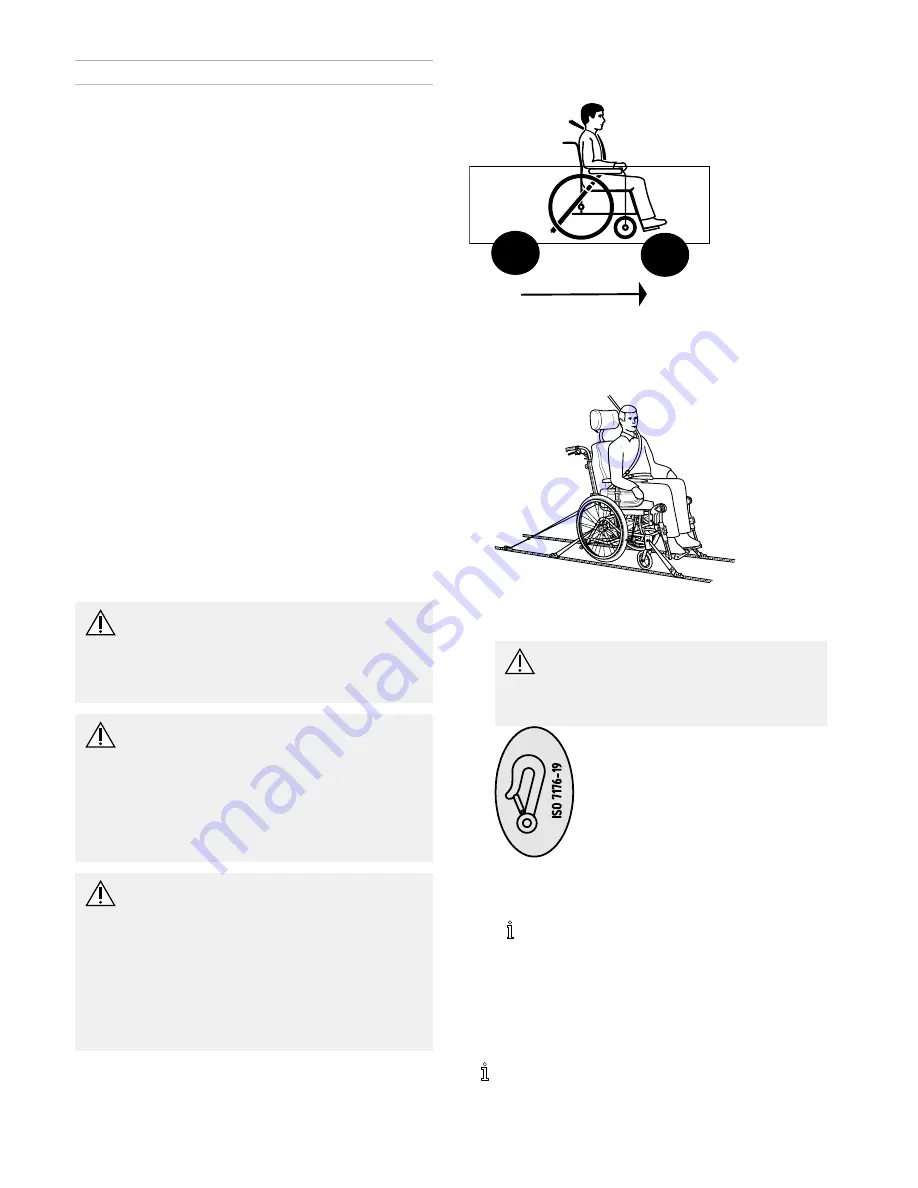
Rea® Clematis®
7 Transport
7.1 Safety information
We would like to inform you about the transport of
wheelchairs with seated users in vehicles that are especially
adapted for this purpose. First and foremost, we would
like to point out that it is always the safest option for the
user to be transported in the vehicle’s regular seat fastened
with the regular safety belt. Invacare cannot recommend
transport seated in the wheelchair. But, we are aware that
there are users and situations that require vehicle transport
seated in the wheelchair. In these cases, the safety rules in
this section must be followed in order to reduce the risk of
injury in the case of an accident.
Please also read section: “Compliance” for further
information.
The wheelchair/mobility base has been tested according
to the specifications in ISO 7176-19 “Wheeled mobility
devices for use as seats in motor vehicles”. This standard
is developed by authorities and specialists and states a
minimum demand on wheelchairs regarding transportation
in vehicles.
However, in situations where conditions defer from the test
conditions or where the guidelines in this manual are not
followed, Invacare cannot be held responsible for the possible
outcome of an accident. Configurations and accessories that
are unsuitable to be used as a seat in transportation in a
vehicle are mentioned later on in this chapter.
Please also read section: “Compliance” for further
information.
WARNING!
Risk of injury
– Safety restraint devices must only be used when
the wheelchair user's weight is 22 kg or more.
When the user weight is lower than 22 kg, do
not use the wheelchair as a seat in a vehicle.
WARNING!
Risk of serious injury during transport
In a vehicle, a user in his wheelchair must be
secured by a safety belt (3-point belt). A posture
belt only is not sufficient as a personal restraint
device.
– Use the posture belt as a complement, but not
as a substitute to the 3-point safety belt, when
transporting the wheelchair user in a vehicle.
WARNING!
Risk of injury if the wheelchair is not properly
secured
In the event of an accident, braking manoeuvre,
etc. you may suffer serious injuries from flying
wheelchair parts.
– Always remove the rear wheels when
transporting the wheelchair.
– Firmly secure all wheelchair components in
the means of transport to prevent them from
coming loose during the journey.
7.2 Transporting occupied / unoccupied
wheelchairs in vehicles
1.
The wheelchair and user should be transported
forward-facing in the travel direction. All auxiliary
equipment such as tables, trunk support, abduction
cushion etc should be removed and stored safely so that
they do not injure anyone during any kind of accident.
2.
The wheelchair should be secured in the vehicle with a
4-point restraint system. The user should wear a 3-point
safety belt secured in the vehicle.
WARNING!
Risk of injury
– Both the 4-point restraint system and
the 3-point safety belt must be approved
according to ISO-10542-2.
3.
The tie-down points on the wheelchair where the
restraint system straps should be placed are marked
with this symbol.
For vehicles where the wheelchair cannot be
restrained, there are no existing test methods. If
there are existing marked areas for wheelchairs
in the vehicle, we recommend to use these and
follow the guidelines, if any, for placing the
wheelchair.
7.2.1 Backrest and seat angles
When transporting an occupied wheelchair in a
vehicle, the recommended angles for backrest and
seat, are 2° for the backrest and 6° for the seat.
24
1439960-D









































